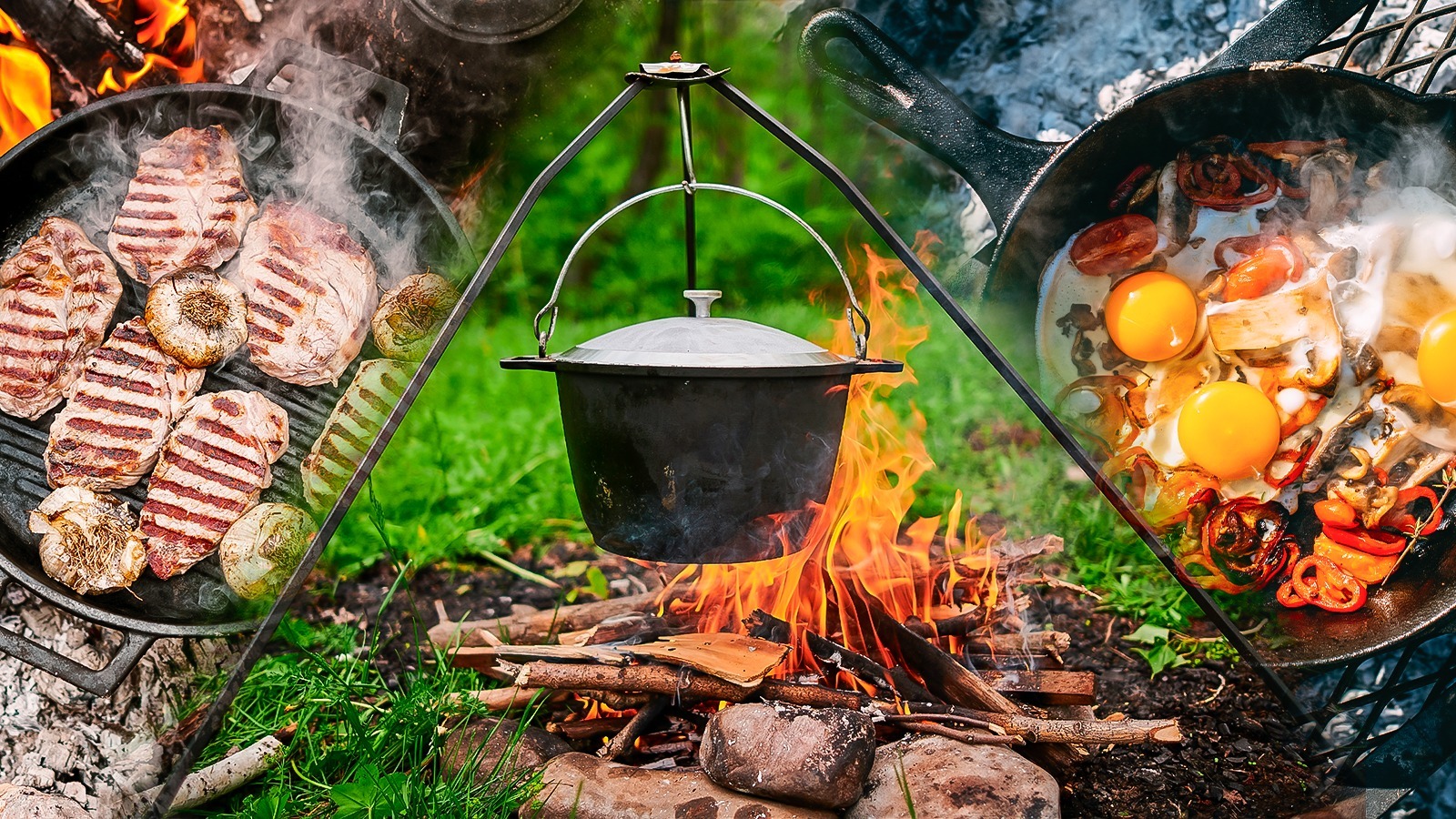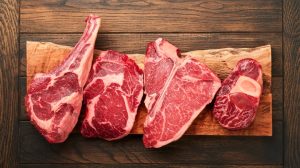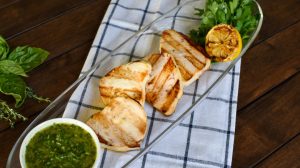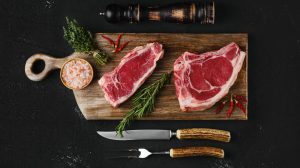Campfires bring us back to nature, giving us comfort while making us sit to savor tranquil moments. They’re also great for adding warmth and chasing away bugs. Whether you prefer camping with friends or family or just want to spend a quiet night in your yard under the stars with your spouse, a campfire makes a welcoming centerpiece for gatherings. The bonus is that just about any food can be cooked over a campfire if you know what you’re doing. We’re here to help you get things right.
From building the right kind of fire to packing the appropriate cooking equipment, campfire cooking can turn an ordinary hamburger or hotdog into a juicy, flame-grilled delight. Take the time during the planning stage to glance over your recipes and stock up on ingredients and cookware so you can enjoy the glamorous meal you will prepare over your campfire. For inspiration, ensure you peruse our tasty camping recipes for your next trip, like hot, comforting chili, saucy, pulled-pork sliders, chicken or steak kebabs, or smoky shakshuka.
Pay attention to the weather forecast and your campfire location
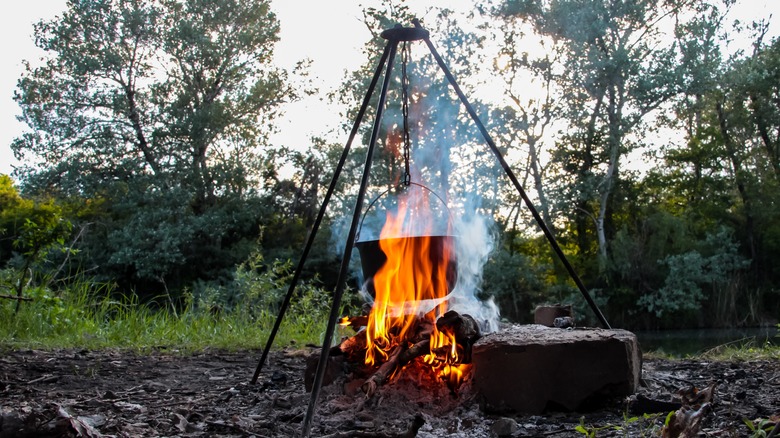
DiPres/Shutterstock
The most important campfire tip is to stay safe — fire is not something to fool around with. It may not be the highlight of campfire cooking but the last thing you want is the fire getting out of control and causing a major catastrophe. If you’re planning a camping trip or Saturday night s’mores, check the weather and stay on top of the local burn laws. It’s not wise to build a fire during dry or windy conditions where hot embers could drift due to strong winds and spark nearby dry kindling. Besides, windy conditions can cause your campfire to flicker wildly, making it difficult to cook food that’s worth eating.
Campfires can be enjoyed in backyards, wooded campgrounds, parks, and on the beach, so pay attention to the immediate area where the campfire will be. Campgrounds and parks have their own rules for building campfires. For that matter, they also typically provide a fire pit or ring, which is already situated in the optimal spot. But if you’re choosing a campfire spot to set up a fire pit or ring, build it at least 15 feet away from any flammable objects, which includes trees, brush, your tent, and personal items.
Build a proper fire so you don’t burn your food
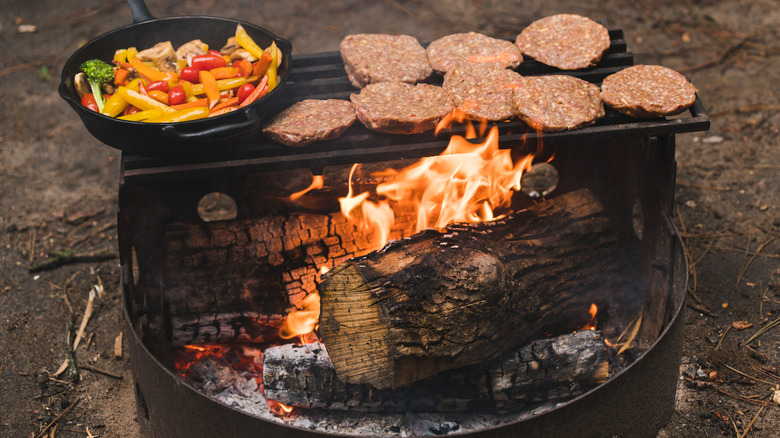
Campfires range in flame size from small to large, but if you’re planning to cook over the fire, shape your wood pile to create the best cooking base. Catering to your campfire correctly — building the foundation, choosing the wood, adjusting the flames, and following your recipe — can make the difference between cursing what turned into charcoal-briquette-looking burgers and rejoicing about scrumptious, juicy red meat.
Choose the right firewood for your campfire; this can depend on where your campfire is located. Many campgrounds and parks have rules for the type of wood you can burn to maintain the integrity of the environment and protect the native species in the area. Use dry, seasoned wood, and avoid fresh-cut, wet, or sappy trees. If possible, consider using the best types of wood for grilling to add flavor to your foods, such as maple, oak, or hickory.
There are varied ways to structure a campfire, which involve placing tinder and kindling in specific patterns to achieve different results. Some patterns, such as a teepee or lean-to style, are best for cooking since they create a smaller, more controlled flame. Both campfire styles also have unique benefits: The former offers easy maintenance, and the latter creates a protective canopy against strong, windy conditions.
Have fire safety gear, preventatives, and treatment on hand
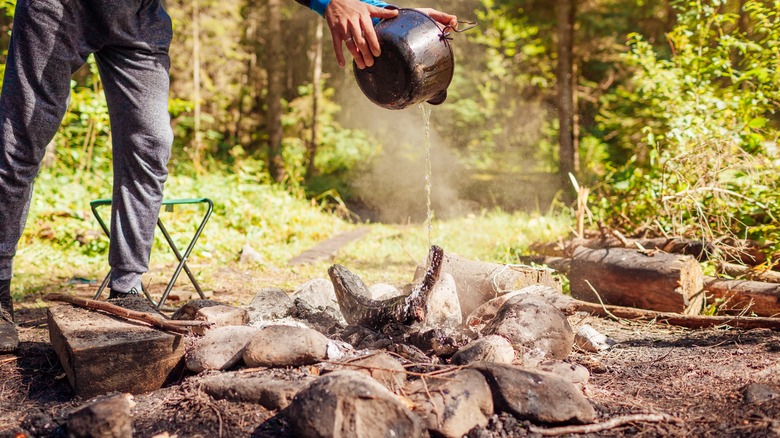
We can’t stress safety enough when it comes to campfires and cooking. It’s all fun and games until your hair goes up in flames. Seriously, though, keep a large bucket of water or sand close by to douse the fire should it begin to get out of control. A good shovel is also convenient for either digging your own fire pit or throwing dirt on the fire. Treat your campfire with the respect it deserves, and you’ll enjoy your time cooking over open flames a lot more.
Furthermore, keep a first-aid kit with you to treat small burns or wounds. A quick tip to prevent burning yourself while working with hot food is to have a bowl of cold water handy to dip your fingers in. Consider having a fire extinguisher, as well, for safely extinguishing a grease fire. Never walk away from a lit campfire, whether you’re cooking or not. And be sure to put the fire out completely when you’re done enjoying its warmth and benefits.
Understand the difference between direct and indirect heat
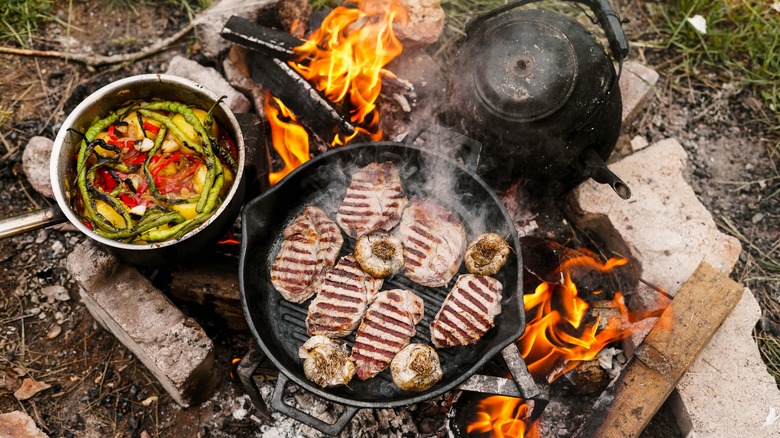
sercan samancii/Shutterstock
Cooking food over a campfire is similar to preparing a meal on a gas stove burner. However, the big difference between the two is direct and indirect heat. When you use a gas stove burner (or campfire), you’re cooking with direct heat — you place your pot or pan on the grate that sits over the flames. Interestingly, campfires also give you the option of cooking with indirect heat. This means you can prepare food without setting it directly on the flames. This method is great for slow-cooked or delicate dishes that otherwise can’t take the high heat. Indirect campfire heat allows you to sear your ribeye or slow-cook your stew with the same fire, often simultaneously.
It helps to be familiar with the fire’s temperature and how it affects cooking. For instance, what temp is ideal for standard cooking, and what would be considered typical for slow cooking? When you place your hand near the fire, how long can you keep it there? A couple of seconds indicates a super-hot cooking temperature — great for searing meat. If you can leave your hand close to the fire for up to about six seconds or so, the radiating heat is considered medium cooking temperature — good for bread or veggies. Nestle your cookware on smoldering coals or the embers from your campfire, either away from the flames or after the fire dies down, to slow cook your food.
Become familiar with camping cookware
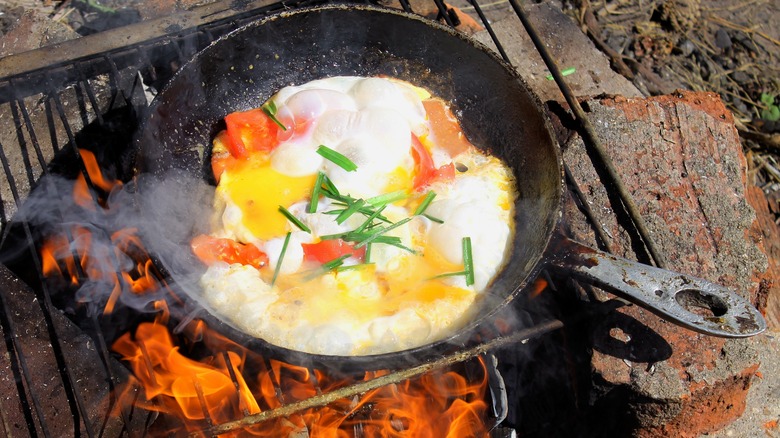
Just like it helps to build a proper fire for cooking, it’s equally important to use the right type of cooking surface and cookware for your campfire meals. Preparing scrumptious eats over an open flame requires using cookware that’s made to withstand intense heat, such as cast iron, stainless steel, titanium, or aluminum. Whether you use a grill grate on top of your campfire or bury a Dutch oven among hot embers, the cookware needs to be sturdy and flameproof.
But your options are vast for making numerous delicious meals — choices include griddles for pancakes or bacon, skillets for eggs or potatoes, deep pots for chili or gumbo, and pans for meat and fish. You can get fancy and set up a rotisserie spit for chicken or go old-school and use a tripod that holds a Dutch oven or other cooking vessel. The tripod keeps the cookware high over the flame so it’s not resting on a grill grate. No need to stick to just basic camping food — knowing which cookware to use enables you to craft almost any recipe you can think of.
Know which camping utensils to use for your recipes
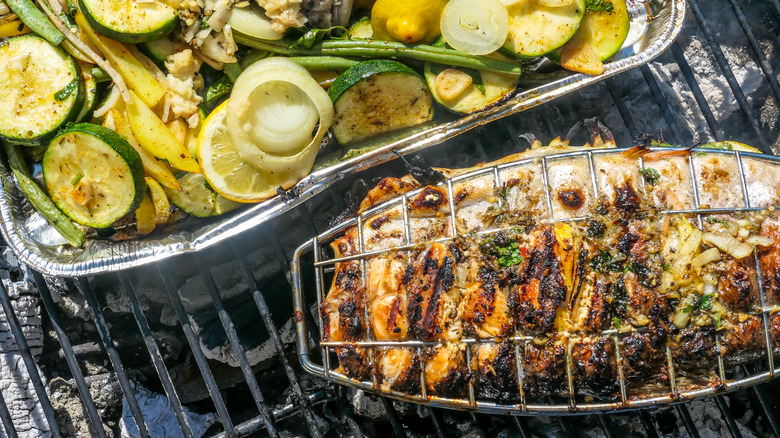
Suppose you plan to fish during your camping trip so you and your family can enjoy fresh-caught trout cooked over your campfire. You certainly don’t want to discover that you forgot the cleaning tools or cooking utensils that can help you properly prepare and cook your incredible catch. (Hint: Bring a grill basket to cook delicate foods.) Nor do you want to wake up at camp one morning looking forward to scrumptious bacon and eggs, only to realize that you don’t have a spatula or tongs. There are numerous foods you can roast over a campfire, but you need to be prepared to do so.
Several cooking utensils will help create a perfectly seared, juicy T-bone or hot, gooey grilled cheese, along with your fresh-caught fish. Even if you make do with utensils reserved for other purposes, you might not get the result you were hoping for. Choose fire-safe, lengthy spatulas, skewers, tongs, or pie irons made from cast iron or stainless steel. But remember to bring heavy-duty oven mitts to safely grab the handles to avoid burning your hand. And don’t forget an instant-read thermometer to grill your preferred meat cuts to your desired doneness.
Do meal preparation at home
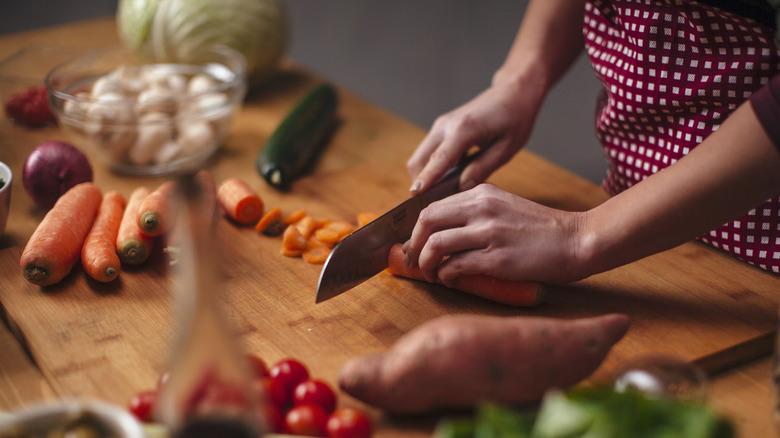
Whether it’s a weekend getaway or an impromptu-friendly gathering, meal prep is best done in your kitchen before heading out to the campsite. It’s better to plan campfire meals, especially if you’re making more than just s’mores. Take advantage of the prep time while you have access to a kitchen full of accessories. Chop, dice, slice, or shred your ingredients to get them ready for each meal. Measure your components so you can quickly throw together your recipes at the campsite. Even if you’re camping at home, moving back and forth between your kitchen and yard can be tedious and let the bugs in.
Planning your meals as much as possible before cooking them over your campfire can also help you determine the type of cookware you’ll need. For dishes like chili, sauce, or soup, add all of your ingredients together beforehand in a pot so the prep work is straightforward. Then you can just prepare it on the campfire. Consider marinating meat or veggies in advance.
Meal prepping for camping also allows you to think about the type of flavor wood you might need for fire to complement your dish. For instance, hickory or mesquite wood adds depth and smokiness to slow-simmering chili. Furthermore, depending on the type of dish you’re cooking, you may need to start your campfire at least an hour before getting started — a primitive way of letting your “oven” come up to temp.
Preserve your food while camping
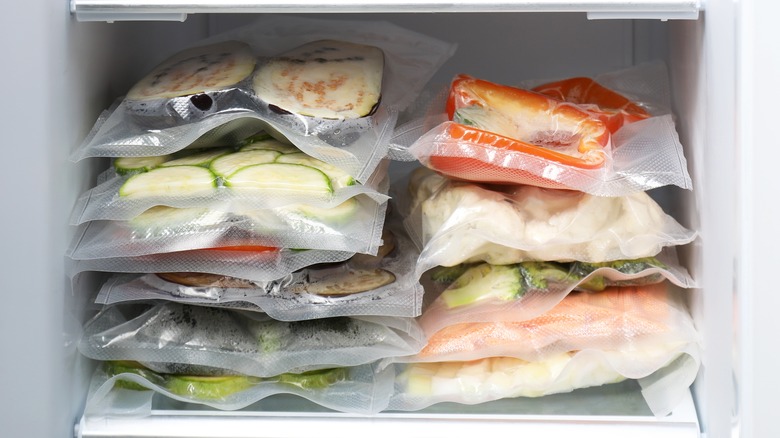
Preserving your food may not be necessary if you’re simply going from your kitchen to the backyard. However, if you’re traveling to a campground, keeping your food safe for a lengthy duration is necessary. You don’t want spoiled food ruining your camping experience. If you’re packing food, consider coolers and invest in ice packs. Ice packs stay frozen longer, and they won’t melt and pour inside the insulated container. Additionally, one-pot meals like stew or chili can be frozen so they double as ice packs to help keep other items cold.
It’s easy to overestimate the amount of space you’ll have after filling your cooler with the right amount of ice. If you fill your cooler with too little ice, your food won’t stay cold (unless you’re enjoying your campfire in the middle of winter and snow). If you overload your cooler with ice, your food will be fit for an igloo. Sealed plastic containers are a convenient and easy way to carry and travel with various ingredients.
Remember to pack other camping accessories
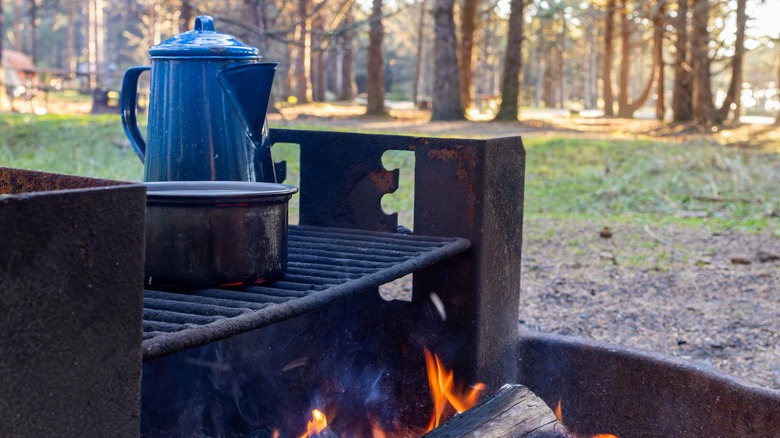
Cooking fresh food over a campfire can be incredibly simple and may not require a lot of thought. But if you’re creating multiple meals or feeding a small army, you may want to bring other camping accessories to make your campfire experience more enjoyable. And if you’re a coffee drinker, don’t forget to season your enamel camping coffee pot prior to summer camping and before bringing it to the campsite and setting it atop or near fiery flames. Plus, a couple of sturdy, heat-proof coffee mugs are in order.
Campfire cooking can be exciting and relaxing, but you may not be happy for long if you forget heat-safe plates and utensils. (We promise not to tell anyone if you use your fingers — camping is, after all, primitive.) In the same vein, when preparing your recipes, consider which seasonings or condiments you want packed to finish off your dishes. A number of miscellaneous items that can round out your campfire cooking include a picnic table cover, portable trash can, cooking apron, and equipment to manage the fire, such as a steel fire poker or log grabber.
If you’re new to campfire cooking, keep it simple
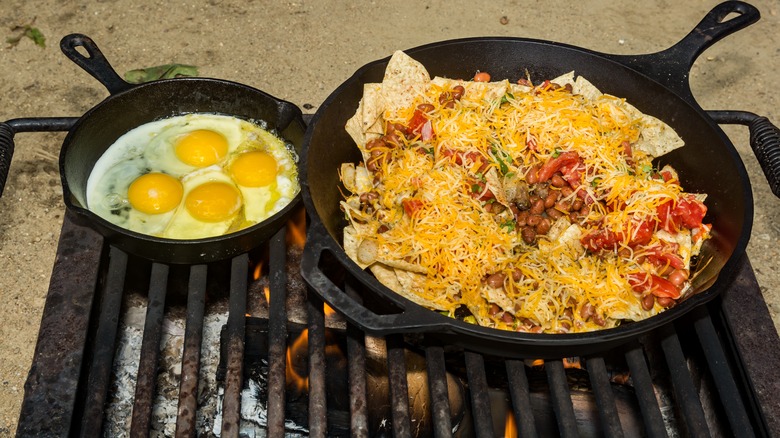
Maybe you’re new to cooking over a campfire and prefer to take it slow. One of the best ways for beginners to cook over a campfire is to put everything in one pan or pot. Choose cast iron if you’ve got it. Not only can it be placed directly on the grill grate over coals or wood, but it also delivers a nice sear on meat and cooks food evenly. You can even make both dinner and dessert or indulge in a midnight snack of nachos all within the same pan — though probably not at the same time. But have you heard of dessert nachos? Instead of cheese, tomatoes, or beans, top your chips with chocolate, peanut butter, marshmallow, or caramel.
Another easy method used by many campers is the foil packet way of cooking. This is better for meals that are prepared gently or just need to be heated through. Though aluminum has its drawbacks, it’s convenient for both direct and indirect cooking over a campfire. And your packets can be prepped at home ahead of time. Campfire potatoes are an easy outdoor dish to begin with — cut up some potatoes, add oil and seasonings, close the packet, and it’s ready to cook via the campfire.
If you’re a campfire pro, think beyond hotdogs, hamburgers, and s’mores
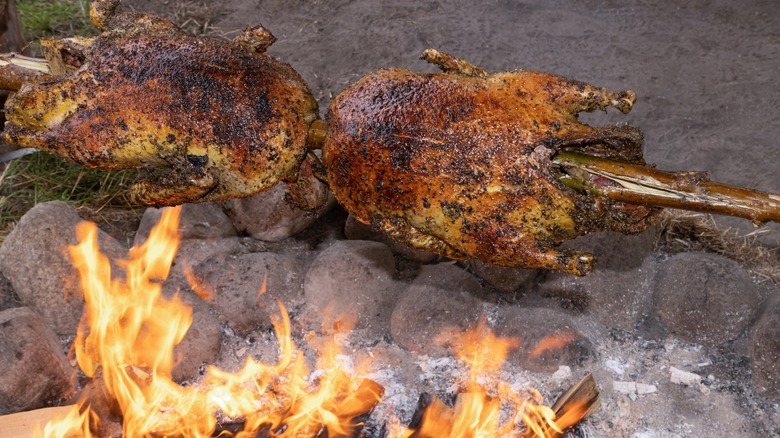
If you already know how to set up a cooking grate over an open flame to fry bacon and eggs in your cast iron pan or set your Dutch oven on hot embers to simmer chili or stew, consider branching out and trying new recipes that stretch your culinary skills. With a large selection of breakfast dishes, snacks, desserts, and delicious meals you can concoct to cook on the campfire, have some fun with it. Experiment with more complex camping cookware and impress your guests with whole hog, leg of lamb, or duck slowly rotating over a fire.
Take along a pie iron to create individual savory or sweet dishes. Place bread or dough at each end of the pie iron and then fill one side with your choice of appetizing ingredients. Close the pie iron to sandwich everything together and place it over the campfire to cook. But you can also enjoy hot beverages — consider creating a warm mulled cider or from-scratch hot cocoa.
Don’t forget dessert
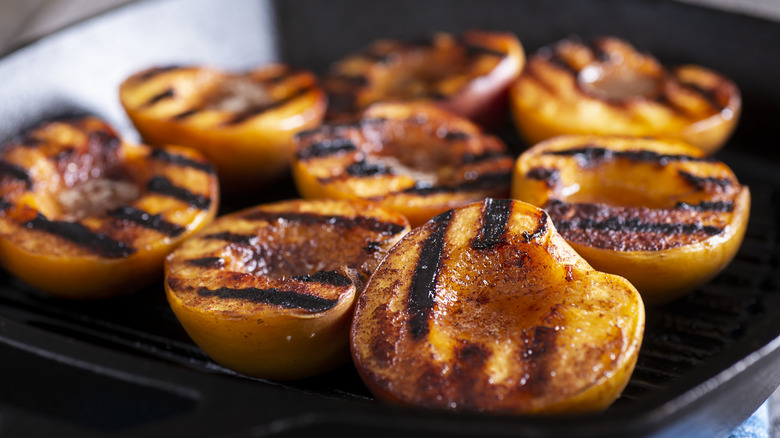
Sitting around a campfire after you’ve spent the afternoon swimming, fishing, hiking, or boating is a relaxing and satisfying way to end an active day. And what better way to finish off the night than with a delectable treat or two? S’mores are probably the most well-known campfire treat, and a quick, delicious tip: add peanut butter for a yummier version. But why stop there? Consider fruit, cheese, coffee, and even bacon as ingredients to play around with for a bedtime snack.
No matter what you consider to be a decadent dessert — chocolate, fruit, pies, or cake, a warm, soothing treat adds coziness, along with the glow of the fire, and contributes to a memorable experience. Whether you choose simple recipes, such as baked apples, glazed peaches, or roasted nuts, or foray into more complex recipes, such as mini muffins or smoked Dutch babies, which are the perfect smoked campfire dessert, there are several sweet eats to indulge in.
Properly clean up when you’re done
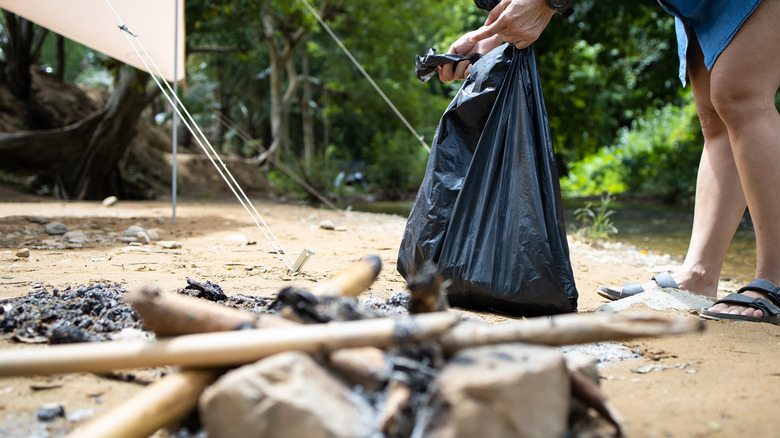
Cooking over a campfire requires cleaning up after yourself. It’s not just your own cookware and dishes you need to clean (don’t forget to bring cleaning items) but the environment as well. The outdoors is not your trash can. If you’re enjoying your campfire meals in a campground, they often have strict rules for disposing of food or other trash. Also, be aware of park rules when it comes to cleaning your cooking equipment. Of course, if you’re at home, cleaning up is much easier.
Be sure to properly dispose of everything in appropriate trash receptacles, and don’t throw food or drink on the ground. It may seem like a good idea since food breaks down, but it attracts the wrong kind of activity, whether it’s bugs, squirrels, raccoons, or bears. On that note, do not feed wildlife. Animals, birds, and insects have their own particular diet, and it doesn’t include processed foods, excess sugar, or non-native fruit or veggies.



